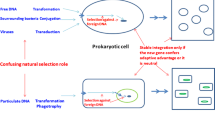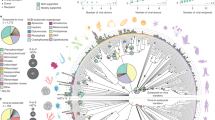Summary
Naturally occurring horizontal gene transfers between nonviral organisms are difficult to prove. Only with the availability of sequence data from a wide variety of organisms can a convincing case be made. In the case of putative gene transfers between prokaryotes and eukaryotes, the minimum requirements for inferring such an event include (1) sequences of the transferred gene or its product from several appropriately divergent eukaryotes and several prokaryotes, and (2) a similar set of sequences from the same (or closely related organisms) for another gene or genes. Given these criteria, we believe that a strong case can be made forEscherichia coli having acquired a second glyceraldehyde-3-phosphate dehydrogenase gene from some eukaryotic host. Ancillary observations on the general rate of change and the time of the prokaryote-eukaryote divergence support the notion.
Similar content being viewed by others
References
Alefounder PR, Perham RN (1989) Identification, molecular cloning and sequence analysis of a gene cluster encoding the class II fructose 1,6-bisphosphate aldolase, 3-phosphoglycerate kinase and a putative second glyceraldehyde 3-phosphate dehydrogenase ofEscherichia coli. Mol Microbiol 3:723–732
Bannister JV, Parker MW (1985) The presence of a copper zinc superoxide dismutase in the bacteriumPhotobacterium leiognathi: a likely case of gene transfer from eukaryotes to prokaryotes. Proc Natl Acad Sci USA 82:149–152
Branlant G, Branlant C (1985) Nucleotide sequence of theEscherichia coli gap gene. Eur J Biochem 150:61–66
Branlant C, Oster T, Branlant G (1989) Nucleotide sequence determination of the DNA region coding forBacillus stearothermophilus glyceraldehyde-3-phosphate dehydrogenase and of the flanking DNA regions required for its expression inEscherichia coli. Gene 75:145–155
Carlson TA, Chelm BK (1986) Apparent eukaryotic origin of glutamine synthetase II from the bacteriumBradyrhizobium japonicum. Nature (London) 322:568–570
Doolittle RF, Feng D-F (1990) A nearest neighbor procedure for relating progressively aligned amino acid sequences. Methods Enzymol 183:659–669
Doolittle RF, Anderson KL, Feng D-F (1989) Estimating the prokaryote-eukaryote divergence time from protein sequences. In: Fernholm B, Bremer K, Jornvall H (eds) The hierarchy of life. Elsevier, Amsterdam, pp 73–85
Fabry S, Hensel R (1988) Primary structure of glyceraldehyde-3-phosphate dehydrogenase deduced from the nucleotide sequence of the thermophilic archaebacteriumMethanothermus fervidus. Gene 64:189–197
Feng D-F, Doolittle RF (1987) Progressive sequence alignment as a prerequisite to correct phylogenetic trees. J Mol Evol 25: 351–360
Feng D-F, Doolittle RF (1990) Progressive alignment of protein sequences. Methods Enzymol 183:375–387
Hensel R, Zwickl P, Fabry S, Lang J, Palm P (1989) Sequence comparison of glyceraldehyde-3-phosphate dehydrogenases from the three urkingdoms: evolutionary implication. Can J Microbiol 35:81–85
Iwaasa H, Takagi T, Shikama K (1989) Protozoan myoglobin fromParamecium caudatum. Its unusual amino acid sequence. J Mol Biol 208:355–358
Leunissen JAM, de Jong WW (1986) Copper/zinc superoxide dismutase: how likely is gene transfer from ponyfish toPhotobacterium leiognathi? J Mol Evol 23:250–258
Longstaff M, Raines CA, McMorrow EM, Bradbeer JW, Dyer TA (1989) Wheat phosphoglycerate kinase: evidence for recombination between the genes for the chloroplastic and cytosolic enzymes. Nucleic Acids Res 17:6569–6580
Martin W, Cerff R (1986) Prokaryotic features of a nucleus-encoded enzyme. Eur J Biochem 159:323–331
Shatters RG, Kahn ML (1989) Glutamine synthetase II inRhizobium: reexamination of the proposed horizontal transfer of DNA from eukaryotes to prokaryotes. J Mol Evol 29:422–428
Steffens GJ, Bannister JV, Bannister WH, Flohe L, Gunzler WA, Kim S-M, Otting FA (1983) The primary structure of Cu−Zn superoxide dismutase fromPhotobacterium leiognathi. Hoppe-Seyler's Z Physiol Chem 364:675–690
Wakabayashi S, Matsubara H, Webster DA (1986) Primary sequence of a dimeric bacterial hemoglobin from vitreoscilla. Nature (London) 322:481–483
Author information
Authors and Affiliations
Rights and permissions
About this article
Cite this article
Doolittle, R.F., Feng, D.F., Anderson, K.L. et al. A naturally occurring horizontal gene transfer from a eukaryote to a prokaryote. J Mol Evol 31, 383–388 (1990). https://doi.org/10.1007/BF02106053
Received:
Revised:
Accepted:
Issue Date:
DOI: https://doi.org/10.1007/BF02106053




